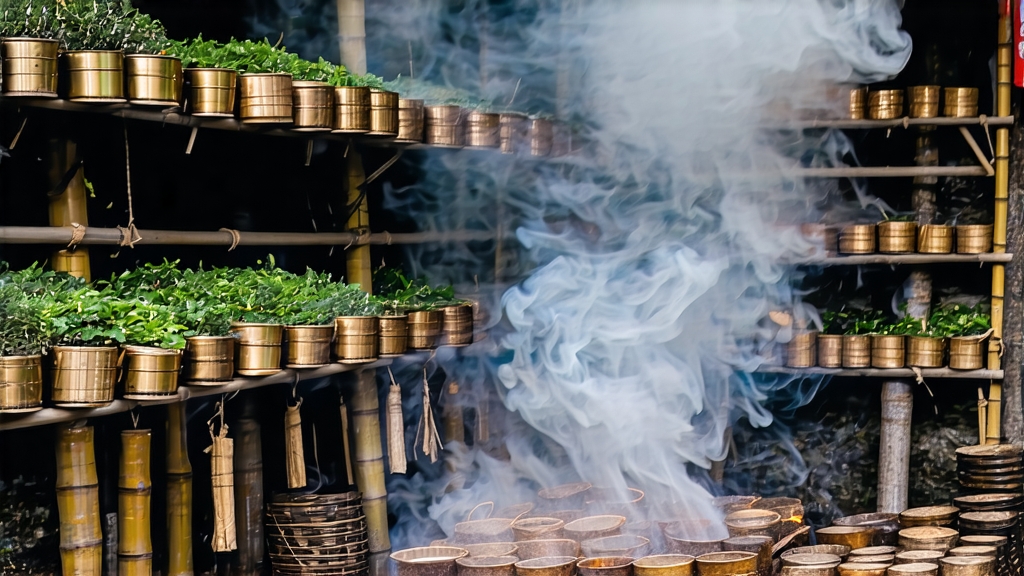
Long before Assam, Ceylon, or Earl Grey entered the English lexicon, there was Lapsang Souchong—an unassuming black leaf from the Wuyi massif in China’s Fujian province that would rewrite the global story of tea. International drinkers often meet this tea through its smoky aroma, yet behind the fragrance of pine embers lies a lineage that reaches back to the late Ming dynasty, a production method unchanged for almost four centuries, and a flavor spectrum far more nuanced than “campfire in a cup.”
Origins and Historical Footprints
Legend places Lapsang’s birth around 1646, when Qing army units allegedly commandeered a village tea factory near Tongmu Pass. To dry the leaves quickly before the soldiers returned, workers spread them over fresh pine fires. The accidental smoke infusion pleased the foreign merchants waiting on the coast at Xiamen, and the style was repeated for export. Whether apocryphal or not, the tale underscores two facts: Lapsang Souchong was the earliest black tea ever documented, and it was created explicitly for long-distance trade. By 1669 the British East India Company listed “bohea souchong” in its ledgers; the term “bohea” (from the local Wuyi pronunciation “Wu-i”) became generic for all Chinese black teas, testimony to Lapsang’s pioneering status.
Terroir: Why Wuyi Cannot Be Cloned
Tongmu Village sits inside a national nature reserve at 27° N latitude, where subtropical bamboo forests mingle with stands of Masson pine and cedar. Day-night temperature swings of 15 °C force the tea bushes—mainly a small-leaf cultivar called cai cha—to produce more amino acids, heightening sweetness. The quartz-rich, yellow-brown soil drains rapidly, stressing roots and concentrating aromatic compounds. Chinese law restricts leaf picking to a narrow window (mid-April to early May) and forbids outside plant material from entering the valley, preserving a microbial terroir impossible to replicate even in neighboring counties.
Leaf Grades and Styles
Western vendors often use “Lapsang Souchong” as a catch-all, yet within Tongmu there are three distinct grades:
- Zhengshan Xiaozhong (“Original Mountain Small Variety”): picked from the highest, mist-shrouded plots; smoked only with 60-year-old pine heartwood for 6–8 hours.
- Wuyi Xiaozhong: same cultivar but from lower elevations; gentler smoke, more cocoa-like body.
- Smoke-Free Xiaozhong: a modern innovation requested by domestic Chinese consumers; dried with hot air rather than pine fire, yielding honeyed stone-fruit notes and a coppery liquor that rivals top Dian Hong.
Crafting the Smoke: A Step-by-Step Journey
- Plucking: One bud plus two leaves, around 6 a.m. while dew still lingers.
- Withering: Spread 3 cm deep on bamboo screens set into wooden racks above a ground-level pine ember pit. Temperature 28–30 °C, humidity 70 %. Leaves lose 60 % moisture over 4–5 hours, absorbing resinous volatiles (α-pinene, longifolene) that will later polymerize into signature smoky lactones.
- Rolling: 45 minutes in a cast-iron drum rotating at 30 rpm; cell walls rupture, enzymes meet substrates, and the pine layer becomes embedded inside the leaf matrix rather than merely coating the surface.
- Oxidation: Nested into cedar-lined wooden crates, 24 °C, 85 % humidity. Oxygen converts catechins into theaflavins (bright notes) and thearubigins (depth). Master sniffers check every 20 minutes; when the leaf turns chocolate-brown with a reddish edge, oxidation stops.
- Second Smoke-Dry: The critical differentiator. Workers fire a pinewood hearth until the logs carbonize but never flame. A perforated bamboo tray ceiling sits 1.2 m above; tea spread here dries in 80 °C convection for 20 minutes, then is tossed, rested, and smoked again—up to three cycles. The goal is 4–5 % residual moisture and a phenolic content of 8–12 mg/g, measured spectroscopically.